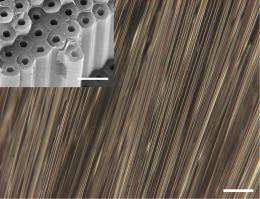First electronic optical fibers with hydrogenated amorphous silicon are developed

(PhysOrg.com) -- A new chemical technique for depositing a non-crystalline form of silicon into the long, ultra-thin pores of optical fibers has been developed by an international team of scientists in the United States and the United Kingdom. The technique, which is the first of its kind to use high-pressure chemistry for making well-developed films and wires of this particular kind of silicon semiconductor, will help scientists to make more-efficient and more-flexible optical fibers. The findings, by an international team led by John Badding, a professor of chemistry at Penn State University, will be published in a future print edition of the Journal of the American Chemical Society.
Badding explained that hydrogenated amorphous silicon -- a noncrystalline form of silicon -- is ideal for applications such as solar cells. Hydrogenated amorphous silicon also would be useful for the light-guiding cores of optical fibers; however, depositing the silicon compound into an optical fiber -- which is thinner than the width of a human hair -- presents a challenge. "Traditionally, hydrogenated amorphous silicon is created using an expensive laboratory device known as a plasma reactor," Badding explained. "Such a reactor begins with a precursor called silane -- a silicon-hydrogen compound. Our goal was not only to find a simpler way to create hydrogenated amorphous silicon using silane, but also to use it in the development of an optical fiber."
Because traditional, low-pressure chemistry techniques cannot be used for depositing hydrogenated amorphous silicon into a fiber, the team had to find another approach. "While the low-pressure plasma reactor technique works well enough for depositing hydrogenated amorphous silicon onto a surface to make solar cells, it does not allow the silane precursor molecules to be pushed into the long, thin holes in an optical fiber," said Pier J. A. Sazio of the University of Southampton in the United Kingdom and one of the team's leaders. "The trick was to develop a high-pressure technique that could force the molecules of silane all the way down into the fiber and then also convert them to amorphous hydrogenated silicon. The high-pressure chemistry technique is unique in allowing the silane to decompose into the useful hydrogenated form of amorphous silicon, rather than the much less-useful non-hydrogenated form that otherwise would form without a plasma reactor. Using pressure in this way is very practical because the optical fibers are so small."
Optical fibers with a non-crystalline form of silicon have many applications. For example, such fibers could be used in telecommunications devices, or even to change laser light into different infrared wavelengths. Infrared light could be used to improve surgical techniques, military countermeasure devices, or chemical-sensing tools, such as those that detect pollutants or environmental toxins. The team members also hope that their research will be used to improve existing solar-cell technology. "What's most exciting about our research is that, for the first time, optical fibers with hydrogenated amorphous silicon are possible; however, our technique also reduces certain production costs, so there's no reason it could not help in the manufacture of less-expensive solar cells, as well," Badding said.
More information: pubs.acs.org/journal/jacsat
Provided by Pennsylvania State University


















